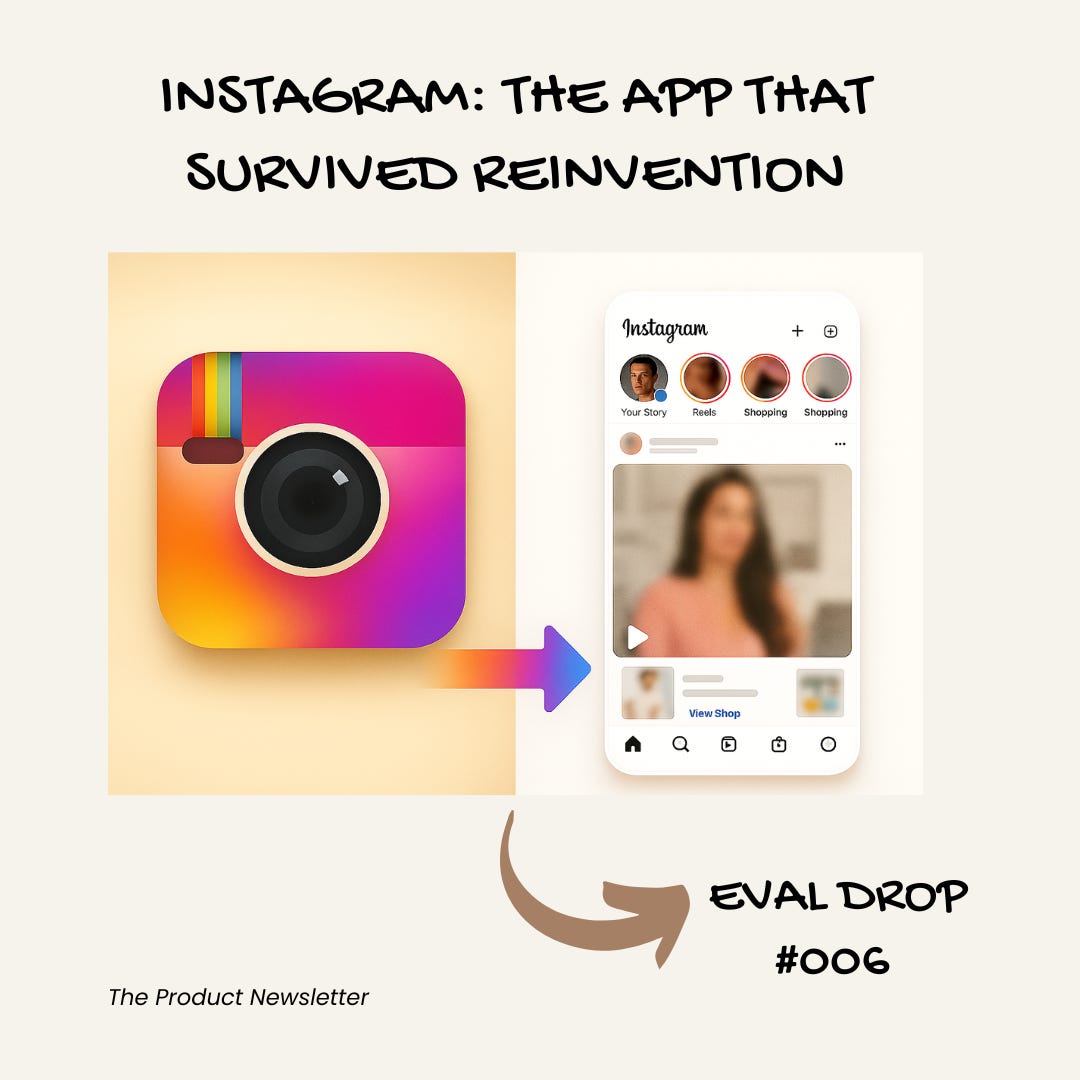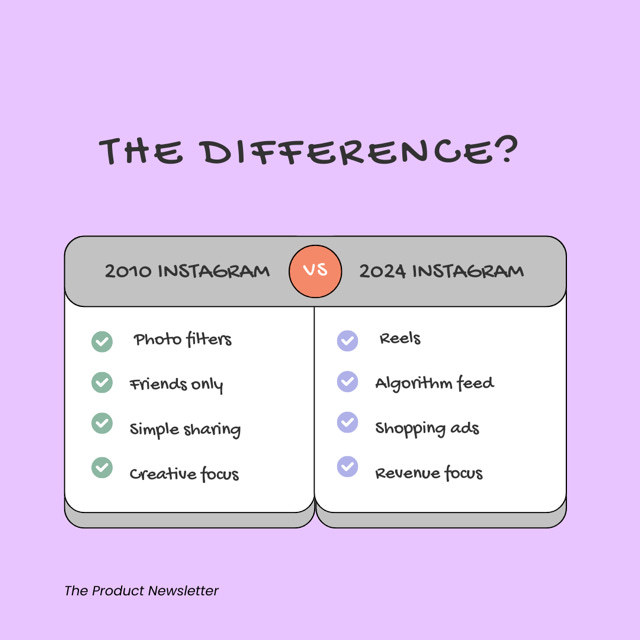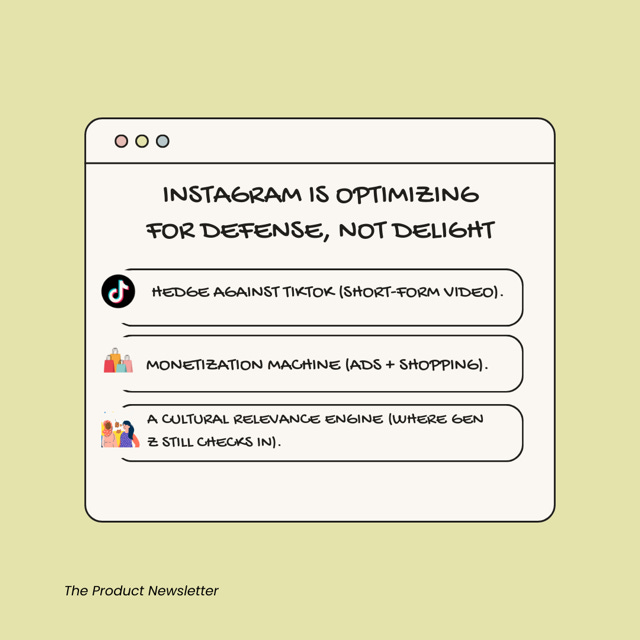Eval Drop #006: Instagram- The App That Survived Reinvention
Instagram should’ve died three pivots ago. This breakdown shows how it kept evolving without ever losing its grip on culture
Hi 👋! You are reading one of my free articles - I hope it helps you level up your PM skills. Want to go deeper? My premium subscribers get exclusive frameworks and strategies I don’t share anywhere else - content that has helped hundreds of product managers land better roles and make bigger impact.
Ready to accelerate your product career? Subscribe now for premium access and join a community of exceptional PMs gaining an edge every week.
Now, let’s dive into today’s insights…
Welcome back! This is Eval Drop #006, the final edition of this August Eval Drop series.
For the past month, we have dissected products used by millions of people every day. From Threads to ChatGPT, YouTube to Chrome; not just to critique them, but to sharpen how we see, perceive, and think about products as Product Managers.
And for the finale, we will tackle one of the most culturally defining apps of the last decade: Instagram. I want to believe this is a special one for everyone, including myself. Almost everyone I know has an Instagram account and uses it in varying ways: either actively posting, doom-scrolling, ghost users who never post like me, or those with obscure burner accounts.
With that said, let’s get into it.
1. What It Is
Instagram launched in 2010 as a photo-sharing app with filters. And since then, it has shape-shifted multiple times: adding Stories, copying Snapchat; adding Reels, copying TikTok; adding Shopping, not quite copying anyone but chasing commerce dreams.
Today, I find Instagram to be less of an app and more of a mirror of internet culture, trying to be everything at once: visual diary, creator platform, entertainment feed, shopping mall, you name it.
2. Who It Serves
Casual users → Photos & stories- staying connected.
Creators → Distribution & Reels virality- monetization.
Advertisers → Targeting across Meta’s ad stack.
Meta → Hedge against TikTok- gateway into Gen Z attention.
3. What It Gets Right
Relentless adaptability
Regardless of what anyone thinks, Instagram does not hesitate to copy. Classic cases of how stories crushed Snapchat, reels diminished TikTok’s dominance, abound if you are looking for more details. But the fact remains that they move rapidly on defense.
Visual-first UX
Beyond doubt, I still find the app to be one of the cleanest, most polished feeds in the consumer apps category. The design is easy on the eyes, less confusing, and they roll out new features almost every week.
Distribution leverage
Backed by Meta’s ad engine, Instagram is the ultimate demand-generation machine for creators and brands. My bet is that this dominance will spread and will be deeply seated in deeper cultural conversations. They took distribution very seriously, knowing that a great product won’t sell itself.
Social graph + discovery
Instagram masterfully blends who you know (friends) with who you want to know (algorithmic discovery). Very few apps I know and have used do both as well as IG does.
4. Where It Falls Short
Identity confusion
Sometimes, one wonders, Is Instagram a diary? A TikTok clone? A shopping platform? Users never quite know. This isn’t a fatal shortfall to me as it means there is a wide range of users, but something to keep an eye on.
Algorithm fatigue
Friends complain they never see each other’s posts. Increasingly, I have found that the algorithm feels optimized for ads and Reels, not connection. This is in line with Meta’s recent monetization drive across its family of services.
Monetization clutter
Regardless of your product management philosophies, you will agree that shoppable posts, ads, influencer links, and commerce overlays at scale erode the “joy of use.”
Creator loyalty
Top creators still see TikTok as their growth engine and YouTube as their bank account. Instagram is often just the middle child.
5. What They’re Optimizing For (My Opinion)
Reels watch time (to keep pace with TikTok).
Ad conversion (especially shoppable posts and influencer collabs).
Creator retention (ensuring talent doesn’t migrate fully to TikTok/YouTube).
Cross-app synergies (Threads integration, Facebook cross-posts).
Instagram’s OKRs aren’t about delight; they are about defense.
6. What I would Do Differently
Clarify identity - Pick the lane: If Instagram is culture-focused, lean fully into community + connection and less of commerce clutter.
Re-balance the feed - Let me toggle: Friends-first vs Discovery-first. Put control back in the user's hands.
Empower creators with ownership - Analytics, monetization, and creative tools that rival TikTok Studio or YouTube Studio.
Double down on Threads integration - Make Instagram + Threads feel like one suite: visual + text, two sides of the same graph.
7. Where It Fits Strategically
For Meta, Instagram is:
A hedge against TikTok (short-form video).
A monetization machine (ads + shopping).
A cultural relevance engine (where Gen Z still checks in).
It’s less innovative now, but it remains Meta’s most important bridge between old Facebook and whatever comes next.
In Summary
Instagram’s survival strategy is simple: copy, adapt, absorb. It works, but at the cost of clarity.
For PMs, this is a strong case study in:
How to defend your turf without losing your soul.
When copying is a strategy, not desperation.
The trade-offs between growth and identity.
Instagram isn’t always loved. But it’s still lived in.
And that is the power of a product that reinvents itself before it gets irrelevant.
What’s Next
That is a wrap for Eval Drops in August. I want to thank you for reading, sharing, and sending in your product requests.
But here is good news: September is a whole new series!
It’s called Building with AI, a weekly newsletter for product managers. I will be sharing practical, hands-on ways to use AI to:
Speed up your PM workflow.
Build sharper strategies and manage execution.
Manage your day-to-day life faster and easier.
If Eval Drops sharpened your product sense, Building with AI will sharpen your product speed.
The first edition of this series drops next week. Stay tuned!
ICYMI: If you’ve been following my newsletter lately, you’ve probably noticed that product evals have become one of my main moats. I believe that breaking down the behind-the-scenes frameworks behind today’s top product market leaders is the cheat code every PM needs. On that note, here are some past issues to get you up to speed 👇🏾
This Chrome Eval is a must-read for every product manager. With an acquisition offer making headlines, it felt like the right time to unpack how a “simple” browser became Google’s $200B distribution engine. Read it here 👇🏾
This article answers the question on every product person’s mind: “How does YouTube manage to stay relevant for over a decade, and what goes on behind the scenes?” Click the link below to find out the answer 👇🏾






